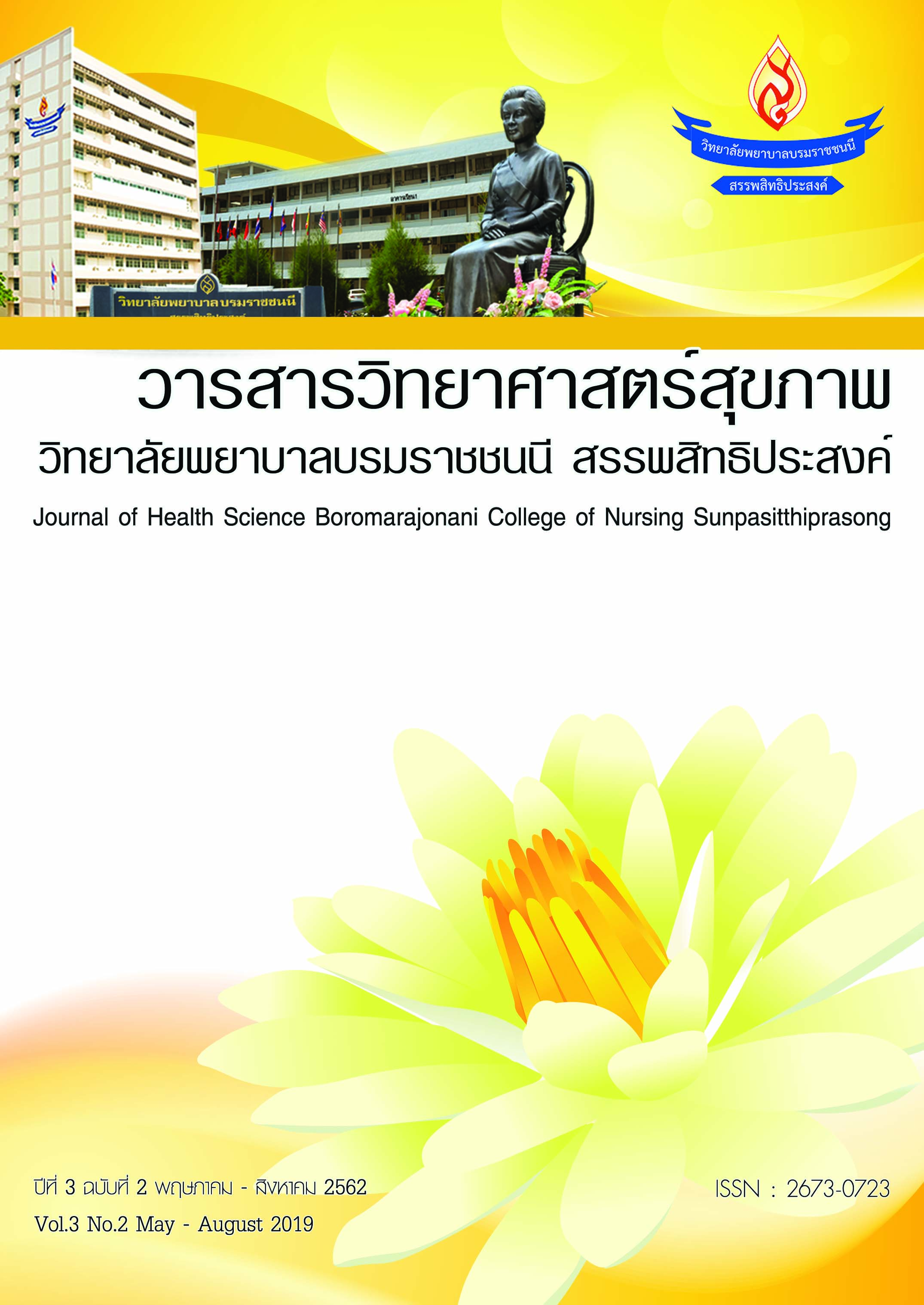ชนิดและประสิทธิภาพของน้ำยาทำความสะอาดอวัยวะสืบพันธุ์เพศหญิง: การทบทวนวรรณกรรมอย่างเป็นระบบ
คำสำคัญ:
อวัยวะสืบพันธุ์เพศหญิง, การติดเชื้อระบบทางเดินปัสสาวะ, น้ำยาทำความสะอาดอวัยวะสืบพันธุ์บทคัดย่อ
การใช้น้ำยาทำความสะอาดอวัยวะสืบพันธุ์ของเพศหญิง เป็นประเด็นหนึ่งที่ยังไม่ชัดเจน อาทิ ชนิดของน้ำยามีความหลากหลาย ประสิทธิภาพ ผลข้างเคียงการนำไปใช้ในสถานการณ์และบริบทของหอผู้ป่วยแตกต่างกัน อย่างไรก็ตามยังไม่มีการรวบรวมและสังเคราะห์ที่ชัดเจน การศึกษาครั้งนี้มีวัตถุประสงค์เพื่อศึกษาชนิด ประสิทธิภาพและผลข้างเคียงของน้ำยาทำความสะอาดอวัยวะสืบพันธุ์ของเพศหญิง จากการทบทวนวรรณกรรมอย่างเป็นระบบตามแนวความคิดของ The Joanna Briggs Institute โดยการสืบค้นรายงานการวิจัยที่ตีพิมพ์เป็นภาษาไทยและภาษาอังกฤษจากฐานข้อมูล ได้แก่ PubMed, CINAHL, Thaijo, และ Google scholar (พ.ศ. 2551 - พ.ศ. 2561) ได้งานวิจัยทั้งสิ้น 89 เรื่อง และมีงานวิจัยที่สอดคล้องกับเกณฑ์คัดเข้า 4 เรื่อง เป็นงานวิจัยเชิงทดลอง และงานวิจัยกึ่งทดลอง จำนวน 1 และ 3 เรื่อง ตามลำดับ ผลการศึกษาพบว่า ชนิดของน้ำยาประกอบไปด้วย สบู่ น้ำสะอาด โฟมทำความสะอาดผิวหนัง 10% โพวิโดนไอโอดีน 2% โพวิโดน ไอโอดีน น้ำเกลือ และน้ำยาเซฟลอน 1 : 100 งานวิจัยส่วนใหญ่แนะนำให้ทำความสะอาดรอบๆ ท่อปัสสาวะ (Periurethral) ด้วยสบู่และน้ำสะอาด และรูเปิดท่อปัสสาวะ (Meatus) ด้วยน้ำเกลือก่อนใส่คาสายสวนปัสสาวะ และใช้เพียงสบู่และน้ำสะอาดทำความสะอาด รอบๆ ท่อปัสสาวะเช้าและเย็น ซึ่งสะท้อนให้เห็นว่าการเลือกใช้วิธีการทำความสะอาดอวัยวะสืบพันธุ์เพศหญิงมีค่อนข้างหลากหลาย ซึ่งควรคำนึงบริบทและความคุ้มค่า ทั้งต่อผู้ป่วยและโรงพยาบาล
References
2.Scott Rd. The Direct Medical Costs of Healthcare- Associated Infections in U.S. Hospitals and the Benefits of Prevention, 2009. Muncie HL, Hoopes JM, Damron DJ, Tenney JH, & Warren JW. Once-daily irrigation of long-term urethral catheters with normal saline. Lack of benefit. Aech Intern Med 1989:149:441-3.
3.สมบัติ ด่านชัยวิจิตร. โรคติดเชื้อในโรงพยาบาล. ใน: กิตติกา ประทีปะเสน, เปรียบเทียบการติดเชื้อระบบทางเดินปัสสาวะในผู้ป่วยหญิงที่คาสายสวนปัสสาวะระหว่างกลุ่มที่ทำความสะอาดด้วยสบู่และน้ำกับน้ำยาเซฟลอน. วิทยานิพนธ์พยาบาลศาสตรมหาบัณฑิต สาขาวิชาการพยาบาลผู้ใหญ่ มหาวิทยาลัยรังสิต; 2558.
4.แผนงานควบคุมโรคติดเชื้อในโรงพยาบาล ปี 2560-2564. สำนักงานป้องกันควบคุมโรค 2559 [อินเตอร์เน็ต]. 2561 [เข้าถึงเมื่อ 9 พ.ค. 2561]. เข้าถึงได้จาก: https://plan.ddc.moph.go.th/meeting30_1augsep/meetting30_1/ Documents/5.%20CD/6.%20แผนงานควบคุมโรคติดเชื้อในโรงพยาบาล.pdf
5.Tambyah PA, Maki DG. Catheter-Associated Urinary Tract Infection Is Rarely Symptomatic: A Prospective Study of 1497 Catheterized Patients. Arch Intern Med 2000;160:678–82.
6.Temiz E, Piskin N, Aydemir H, Oztoprak N, Akduman D, Celebi G, Kokturk F. Factors associated with catheter-associated urinary tract infections and the effects of other concomitant nosocomial infections in intensive care units. Scand J Infect Dis 2012;44:344-9.
7.Leone M, Albenese J, Gamier F, Sapin C, Barrau K, Bimar MC et al. Risk factors of nosocomial catheter-associated urinary tract infection in a polyvalent intensive care unit. Intensive Care Unit 2003;29:929-32.
8.Crouzet J, Bertrand X, Venier AG, Badoz M, Husson C, Talon D. Control of the duration of urinary catheterization: impact on catheter-associated urinary tract infection. J Hosp Infect 2007;67:253-7.
9.Guideline summary: Catheterisation. Indwelling catheters in adults: urethral and suprapubic [Internet]. 2012 [cited 2018 April 28]. Available from: https://repositori.udl.cat/bitstream/handle/10459.1/44931/EAUN_Paris_Guideline_2012.pdf?sequence=1&isAllowed=y
10.Guideline for Prevention of Catheter-Associated Urinary Tract Infections. Healthcare Infection Control Practices Advisory Committee (HICPAC) [Internet]; 2012 [cited 2018 April 28]. Available from: https://www.cdc.gov/infectioncontrol/pdf/guidelines/cauti-guidelines.pdf
11.Webster J, Hood RH, Burridge CA, Doidge ML, Phillips KM, George N. Water or antisseptic for periurethral cleaning before urinary catheterization: a randomized controlled trial. Am J Infect Control 2001;29:389-94.
12.The Joanna Briggs Institute Levels of Evidence and Grade of Recommendation Working Party. Supporting document for the Joanna Briggs Institute levels of evidence and grades of recommendation [Internet]. 2014 [cited 2018 May 30]. Available from: https://joannabriggs.org/jbi-approach.html#tabbednav=Levels-of-Evidence
13.Jeong I, Park S, Jeong SJ, Kim SD, Choi SY, Lee SY, et al. Comparison of Catheter-associated Urinary Tract Infection Rates by Perineal Care Agents in Intensive Care Units. Asian Nurs Res 2010;4:141-50.
14.จิณณภัทร ช้างมุกดา, สุพรรณภา ตราทอง, จิรภา มิ่งแม้น. การเปรียบเทียบผลการทำความสะอาดอวัยวะสืบพันธุ์ในผู้ป่วยคาสาวสวนปัสสาวะระหว่างการใช้น้ำยาฆ่าเชื้อกับน้ำสบู่ หอผู้ป่วยหนักศัลยกรรม โรงพยาบาลพระจอมเกล้า จังหวัดเพชรบุรี [อินเตอร์เน็ต]. 2554 [เข้าถึงเมื่อ19 พ.ค. 2561]. เข้าถึงได้จากhttps://www.google.com/search?safe=active&rlz=1C1CHBD_enTH822TH8
15.กิตติกา ประทีปะเสน. เปรียบเทียบการติดเชื้อระบบทางเดินปัสสาวะในผู้ป่วยหญิงที่คาสายสวนปัสสาวะระกว่างกลุ่มที่ทำความสะอาดด้วยสบู่ และน้ำ กับน้ำยาเซฟลอน [อินเตอร์เน็ต]. 2558 [เข้าถึงเมื่อ 9 พ.ค. 2561]. เข้าถึงได้จาก: https://www.gotoknow.org/posts/78962
16.Lisum K, Widani NL. Periurethral cleansing solution again bacterial colonization count in the periurethral area prior to urinary catherization. Indonesian nursing journal of education and clinic 2016;1:66-70.
Downloads
เผยแพร่แล้ว
How to Cite
ฉบับ
บท
License
บทความที่ได้รับการตีพิมพ์เป็นลิขสิทธิ์ของวารสารวิทยาศาสตร์สุขภาพ วิทยาลัยพยาบาลบรมราชชนนี สรรพสิทธิประสงค์ ข้อความที่ปรากฏในบทความแต่ละเรื่องเป็นความคิดเห็นส่วนตัวของผู้เขียนแต่ละท่านไม่เกี่ยวข้องกับวิทยาลัยพยาบาลบรมราชชนนี สรรพสิทธิประสงค์ และคณาจารย์ท่านอื่นๆ ในวิทยาลัยพยาบาลฯ ความรับผิดชอบเกี่ยวกับบทความแต่ละเรื่องผู้เขียนจะรับผิดชอบของตนเอง



